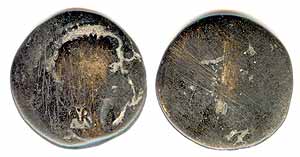
AMR
Host coin maybe Augustus, but more probably Claudius: AMR monogram (Amorim, Asia) (19mm 4.9g) Howgego 604

Examples
from the Richard Baker Collection of
Roman Countermarks (since sold in various auctions)
_________________________________________________________________________________________
Text by Richard
Baker (RMBAKER2@webtv.net)
and Andreas Pangerl
(cassiporis @yahoo.de),
Fotos taken by Mike Connor, reworked by Hannes Mayer
(www.ancientcoins.biz),
Questions ?
For questions
please contact Andreas Pangerl.
_________________________________________________________________________________________
Coins
of this private collection are also included in the virtual Museum of
Countermarks
on Roman Coins'
Alphabeticial
Systematic Catalogue , and in the Museum Main Section
sorted by host coin.
Please
see also in the Legionary
Countermark
section.
All
countermarks below are referenced to "MPC" = Pangerl
Collection Systematic
Catalogue Number,
or
the Howgego
Greek Imperial Countermark Catalogue Number
as appropriate.
_________________________________________________________________________________________
Click
on images to enlarge !

AMR
Host coin maybe
Augustus,
but more probably Claudius: AMR monogram (Amorim, Asia) (19mm 4.9g)
Howgego
604
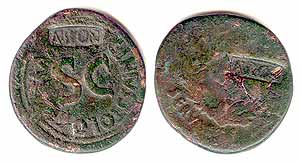
APRON
Sestertius of
Augustus (P.
Licinius Stolo): APRON - Lucius Apronius (governor in Africa &
elsewhere
under Tiberius) 37mm 25.3g
There are other
versions
of APRONI. Countermark Martini Pangerl Collection 112
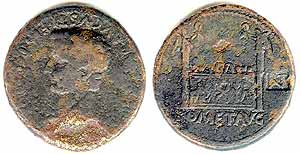
ARAT
Rare portrait
sestertius
of Tiberius, facing left: ARAT - Arationibus 35mm 24.7g, Countermark
Martini
Pangerl Collection 7
Altar Lugdunum
to 'Rome&Augustus'
The ARAT
monogram ctmk. seems
to be found only on Tiberius Sestertii and As' minted under Augustus'
later
years. Arationibus appears to be a title for the top imperial fiscal
administrator
within designated area of operation.
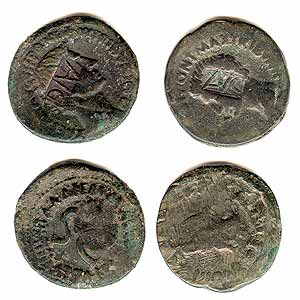
AVG
2 As of
Augustus: AVG (both
coins maybe ancient cast-counterfeits) (29mm 9.6g; 28mm 11.0g),
Countermark
Martini Pangerl Collection 75
AVG: The
abbreviation of
Augustus. It's usage here is an Imperial title as opposed to a personal
name. Some instances of this countermark may refer to Augustus himself,
but, more likely most instances refer to Tiberius and possibly
Caligula.
Originally bestowed upon Octavian in 27BC as an honorific title, it
later
became a title adopted by each reigning emperor.
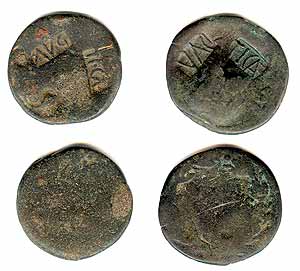
AVC,
TICAE
Barbaric balkan
ctmked As:
AVG, TICAE (26mm 8.3g; 24.5mm 4.8g), Countermark Martini Pangerl
Collection
83, 90
The left
specimen also has
an 'incuse' S, which may signify the coins downgrading to a Semis
(mentioned
in another listing)
The TICAE refers
to the emperor
Tiberius Caesar. The abbreviation of AVG is as as mentioned before most
likely another title for Tiberius.
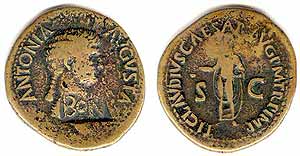
BON
Dupondius of
Antonia: BON
meaning 'Bonum' = 'good' , 33mm 15.6g, Countermark Martini
Pangerl
Collection 42
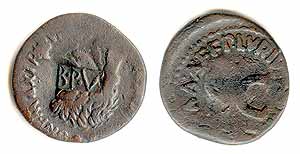
BPV
Early As of
Augustus: unknown
countermark BPV 27mm 8.0g
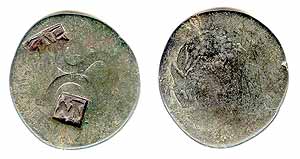
CAE, MT
Sestertius of
Augustus: CAE,
MT(?) (possibly NP?) 33.5mm 20.1g, Countermark Martini Pangerl
Collection
77, imitation 80 (?)
Since the CAE
(for Caesar)
is of barbaric style, the other ctmk. is most likely a blundered,
barbaric
version of IMP.
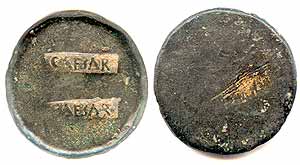
CAESAR
Unknown coin
with rare ctmk's:
CAESAR 25mm 10.0g bevelled edge
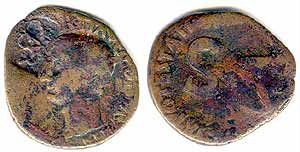
CAESAR
Imitative As of
Drusus struck
after 22AD: Monogram for title CAESAR (25 by 28mm 9.7g), Countermark
Martini
Pangerl Collection 43,
Here we have the
identifying
host coin which proves that the earlier assumption that this was a
Germanicus
ctmk. is not possible. Germanicus died in 19AD. The earliest possible
date
for this host coin is after 22AD.
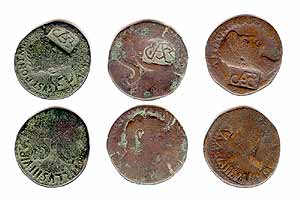
CAESAR
As of Augustus:
Caesar monogram
(27mm 8.8g; 27mm 9.7g; 27mm 9.1g), Countermark Martini Pangerl
Collection
43.
At first
personal as well
as a family name, 'CAESAR' became the normal title used by the
designated
successor to the throne. Originally thought to refer to Germanicus, it
is now apparent that it was meant to refer to Tiberius as designated
heir
and later as reigning 'Caesar'.
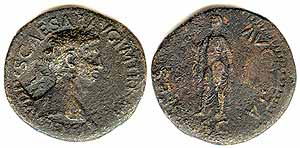
Capricorn
Sestertius of
Claudius: Balkan
Mint: Capricorn with symbol beneath 38mm 26.4g, Countermark Martini
Pangerl
Collection 94,
The Capricorn,
originally
a sign related to Augustus, it became a symbol of Vespasianus' reign
also.
The emblem beneath could be variously interpreted as a plough or a
globe
with ships rudder (as on Tiberian dupondii)
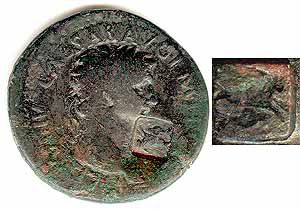
Capricorn
Another
imitative sestertius
of Claudius: Capricorn with symbol beneath (38mm 26.4g), Countermark
Martini
Pangerl Collection 94
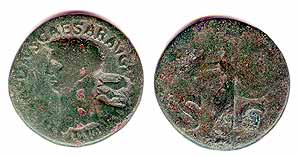
Capricorn
As of Claudius:
Capricorn;
object (globe? rudder?) beneath 29mm 11.9g, Countermark Martini Pangerl
Collection 94
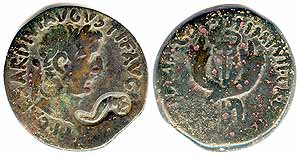
Cornucopiae
Provincial of
Tiberius from
Commagene: Cornucopiae ctmk. (29mm 13.3g Howgego 401)
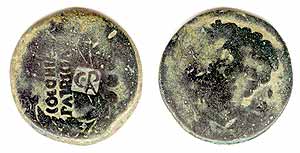
C•PA
AE 24 mm of
Augustus from
Colonia Patricia, Spain: C•PA monogram ctmk. for Colonia
Patricia (9.9g)
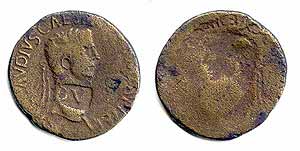
DV
Imitative
Sestertius (brockage)
of Claudius: DV for dupondius (32mm 11.7g), Countermark Martini Pangerl
Collection 85
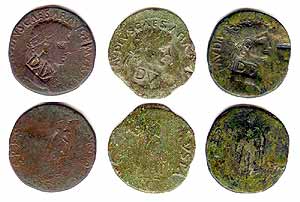
DV
3 barbaric
immitative Sestertii
of Claudius: DV - revaluation to a dupondius (34mm 22.1g; 34mm 13.7g;
33mm
13.9g),Countermark Martini Pangerl Collection 85.
The DV
countermark which
is short for Dupondius is in this form found on coins out of the
'balkans'.
It is almost always accompanied by an edge 'cut' near the 3 o'clock
position.

DV
Imitative
Sestertius: DV
ctmk. (retrograde) - cut in half for change (35mm longwise 14.1g),
Countermark
Martini Pangerl Collection 85
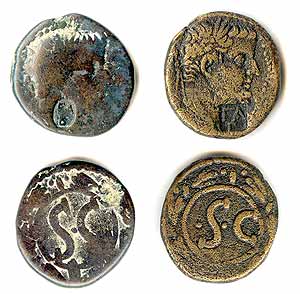
GAB, GAG
2 coins of
Tiberius from
Antioch, Syria: GAB (Gaius, year two); GAG (Gaius, year three) (26mm
13.39g;
26mm 13.5g) Howgego 521 & 522
There are no
known AE issues
from Antioch for Caligulas short reign.
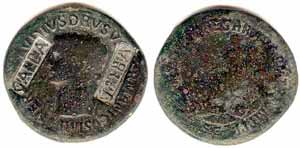
GALBA
Sestertius Nero
Claudius
Drusus: GALBA ctmk. (35mm 27.6g, Countermark Martini Pangerl Collection
86 = Howgego 591). Rare latin GALBA ctmk. struck twice, once
over
earlier ctmk.
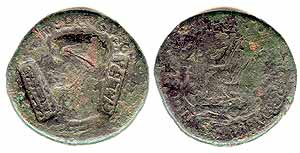
GALBA
Another
Sestertius of Nero
Claudius Drusus: GALBA ctmk. (38mm 26.8g) 'GALBA' struck twice, once
over
an ealier ctmk. Countermark Martini Pangerl Collection 86.
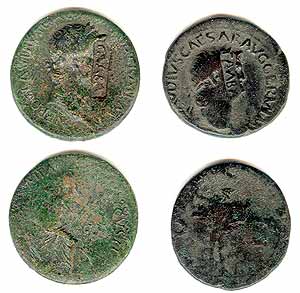
GALBA
Balkan mint As'
of Nero:
GALBA ctmk. in greek (28mm 10.7g; 28mm 9.9g), Countermark Martini
Pangerl
Collection 92.
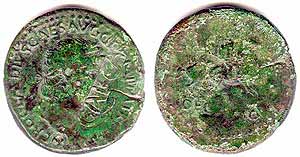
GAL•CA
Sestertius Nero:
GAL•CA for
Galba Caesar 35mm 22.8g
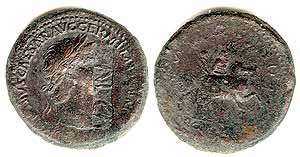
GAL•CA
Sestertius Nero:
GAL•CA for
Galba Caesar 35mm 24.3g
Two "rare"
unlisted "latin"
variant ctmk's instead of the usual greek GALKAI
Both coins from
balkan mint
(Perinthus?)
There are so far
5 known,
all of which appear to be from the same ctmk. die.
3 are on Nero
Sestertii,
1 is on a Claudius Sestertius and 1 is on an unknown Julio-Claudian
Sestertius.
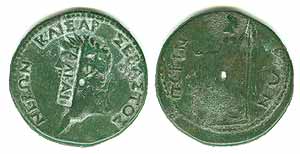
GALKAI
Large sestertius
sized coin
(33mm 18.1g) of Nero: mint of Perinthus
GALKAI = Galba
Caesar - Countermark
Martini Pangerl Collection 93 = Howgego 527
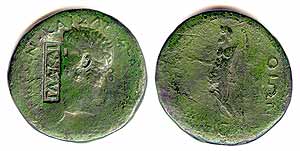
GALKAI
Another example:
same as
above: 32mm 19.8g, Countermark Martini Pangerl Collection 93
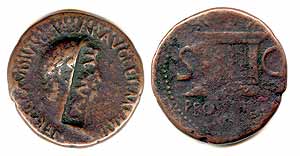
GALKAI
Modern fake cast
coin resembling
balkan Nero As with GALKAI ctmk., Countermark Martini Pangerl
Collection
93
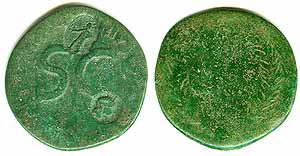
Helios
Early Augustan
Sestertius:
Radiate head of Helios r.; std. lunar deity with crescent above head
Also referred to
as a 'nailed
helmet'. Sometimes this 'radiate' head is found struck twice on
examples
of Augustan sestertii and, occasionally, it is found paired with this
standing
lunar diety. This latter type should make the 'Helios' designation of
the
other countermark a certainty. Countermark Martini Pangerl Collection
65.
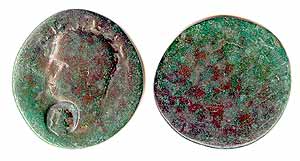
Hercules
As of Agrippa:
Head of Hercules
(Melqart?) 29mm 9.0g, Countermark Martini Pangerl Collection 99
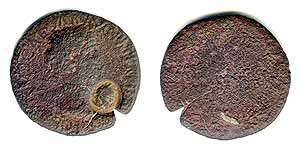
Hercules
Head
Large 'pseudo'
Sestertius
of Claudius: Bearded head of Hercules in circle 35mm 18.8g, Countermark
Martini Pangerl Collection 99
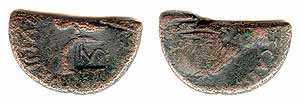
IMP
As of Augustus
cut for change:
IMP - Imperator (27.5mm 6.7g), Countermark Martini Pangerl Collection 79
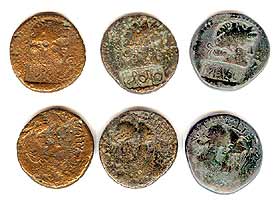
IMP -
GAL , IMP OTHO,
IMP VES
IMP GAL
(Imperator Galba
23mm 7.9g); IMPOTHO (Imperator Otho 23mm 8.2g); IMP-VES(retrograde)P
(Imperator
Vespasianus 23mm 8.2g); Coins of Nero from Tripolis
The title
'Imperator' referred
to the undisputed head of the armies.
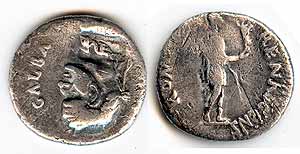
IMP•VES
Rare spanish
denarius of
Galba: IMP•VES (18mm 3.2g), Countermark Martini Pangerl
Collection 100
The coins
obverse inscription
reads Imperator Galba. It was struck when he was nominally declaring
himself
the general of the Senate and people of Rome, but not (albeit
deceptively)
the emperor. The ctmk. IMP•VES says the same words, but with a
different
meaning. There the head of the armies is the declared emperor.
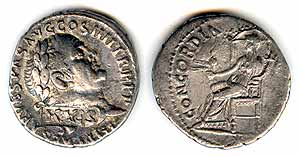
IMP•VES
Denarius of
Vespasianus 72AD:
IMP•VES (18mm 3.2g), Countermark Martini Pangerl Collection 100
Extremely rare.
Only a few
known eastern mint denarii, which have been mistakenly countermarked
with
his own monogram.
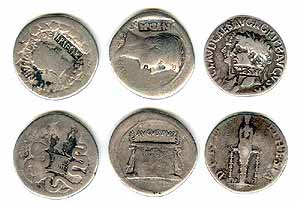
IMPVESAVG
Marcus Antonius,
Augustus,
Claudius/Agrippina Cistophorii: IMPVESAVG (Imperator Vespasianus
Augustus
26mm 10.7g; 26mm 11.1g; 25.5mm 10.4g), Countermark Martini Pangerl
Collection
101
Used exclusively
on Cistophorii.
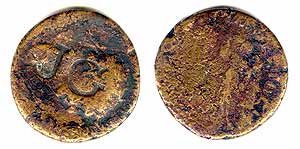
JG
Provincial of
Traianus: JG
(modern punched ctmk - could be 19th or 20th century) (27mm 10.1g)
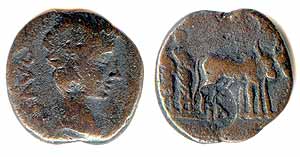
KLIA
AE of Augustus:
KLIA in circle
- Claudius year 12 (52AD) 2.7g Howgego 546
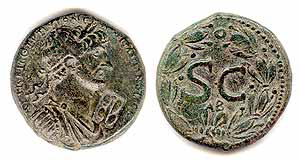
Laurel
Hadrian from
Antioch, Syria:
Laurel branch ctmk. (associated with Apollo at Antioch) (25mm 11.2g;
26mm
16.1g) Howgego 378
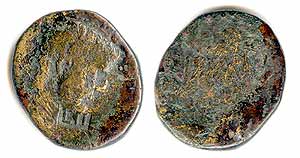
L II
AE of Augustus
(or Tiberius):
LII - Legion 2 (27mm 12.0g)
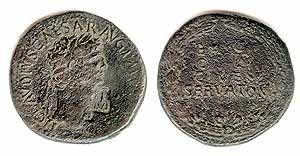
LVI
Sestertius of
Claudius: Gallic
Mint: LVI and club of Hercules ctmk. for Legion VI Victrix 36mm 22.8g
The legion VI
Victrix was
Galba's personal legion, under his command. It was the first to declare
him emperor.
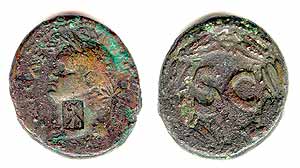
Minerva
standing
Vespasianus coin
of Antioch:
Minerva ctmk 29mm 17.0g Howgego 245
This countermark
is usually
found on Domitian coins, occasionally on Nero coins and extremely rare
on Vespasian.
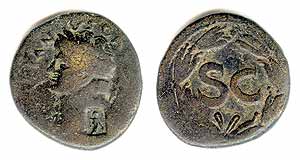
Minerva
standing
Domitianus coin
of Antioch:
Minerva ctmk (28mm 13.5g)
Minerva was
Domitians favorite
diety. As such this probably had some sort of official imperial as
opposed
to colonial use.
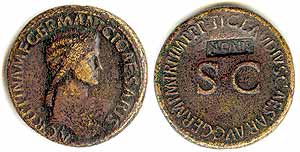
NCAPR
Sestertius of
Agrippina Sr.:
NCAPR ctmk. 35mm 26.4g
NCAPR: There are
several
interpretations of what this, the most interesting of all
Julio-Caludian
ctmk., means. The two most likely are:
1. Nero Ceasar
Augustus Populi
Romani
2. Nero Caesar
Augustus Probavit
In the first
instance it
is a congiarium or public dole given by Nero to the people of Rome. In
the second, it is a revalidation of the earlier coins of ones
predecessors
still in circulation.
Possible is also
a later
use, eg. by Nerva, or that no emperors name was part of the
countermark,
Countermark Martini Pangerl Collection 1; 20; 60 depending on subtype
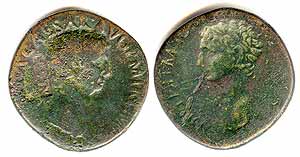
NCAPR
Sestertius
Claudius: NCAPR
ctmk.; gallic mint (35mm 24.1g), Countermark Martini Pangerl Collection
1; 20; 60 depending on subtype
Both a brockage
of a sestertius
and ctmked with NCAPR
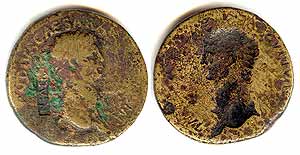
NCAPR
Another rare
example: Sestertius
of Claudius: NCAPR ctmk.; Also a brockage as well as a ctmk. Unofficial
mint (35mm 24.5g), Countermark Martini Pangerl Collection 1; 20; 60
depending
on subtype
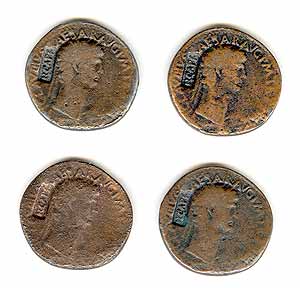
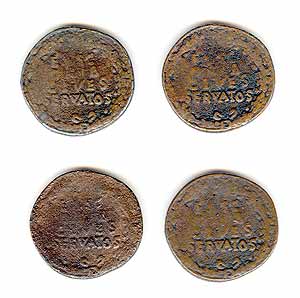
NCAPR
4 modern fakes
of Claudius
Sestertii with NCAPR ctmk. (all 34mm; 22.4g; 22.9g; 22.9g; 23.9g)
Top two appear
to be copperish
or bronze coating over a 'pewter' colored metal - flaking at edges on
top
left example.
Photographed and
documented
as a fake in Gregory G. Brunks articles, 'The Ancient Countermarks',
appearing
in the Nov., Dec. 1974 and Jan. 1975 issues of the 'Numismatist'.
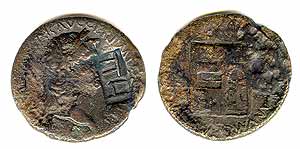
PI
Sestertius of
Nero: [PI]
for Palmyra and the aramaic T for Tadmor (original name for Palmyra)
35.5mm
21.8g Howgego 683
An almost exact
specimen
of this countermark was noted on a Sestertius of Nero with a Port of
Ostia
reverse.
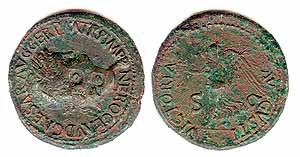
PR
As of Nero:
incuse PR (31mm
12.6g), related to Countermark Martini Pangerl Collection 87
PR - Populi
Romani - connected
with Vindex' revolt in Gaul in March 68AD.
Very unusual as
an incuse
ctmk.
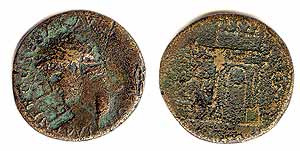
PR
Sestertius of
Nero: PR (retrograde)
- revolt of Vindex 34mm 21.3g, related to Countermark Martini Pangerl
Collection
87
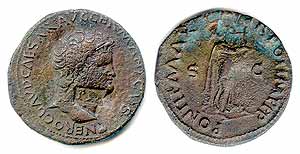
PR
As of Nero: PR -
Populi Romani
- Revolt of Vindex 27mm 9.6g, related to Countermark Martini Pangerl
Collection
87
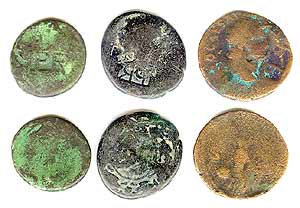
PR
Provincial with
PR (25mm
8.7g); Provincial with PR(retrograde) and LXV = Legion 15 (27.5mm
14.3g);
1 As of Nero with retrograde PR (29mm 14.3), Countermark Martini
Pangerl
Collection 87
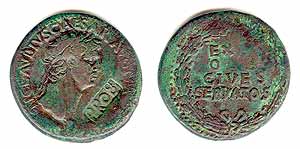
PROB
Imitative
sestertius of Claudius:
British or, more likely Gallic Mint: PROB ctmk. = "Probatum" meaning
approved.
(41mm 24.8g), related to Countermark Martini Pangerl Collection 2, or 23
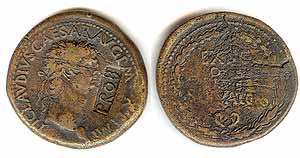
PROB
Unofficial
Sestertius Claudius:
PROB (- Probatum -> approved) 37mm 23.9g, Countermark Martini
Pangerl Collection
2, or 23
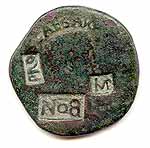
PRO,
BON, IMP
Possible
imitative sestertius
of Claudius: PRO, BON, IMP 38mm 24.7g, from Germania inferior
1. PRO =
Probatum - 'approved',
Countermark Martini Pangerl Collection 48
2. BON = Bonum -
'good',
Countermark Martini Pangerl Collection 42
3. IMP =
Imperator, Countermark
Martini Pangerl Collection 47
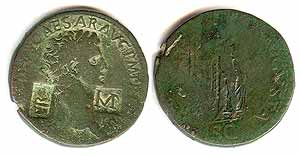
PRO, IMP
Sestertius
Claudius: PRO,
IMP ctmks. Unofficial mint 36mm 26.6g, Countermark Martini Pangerl
Collection
48, 47
Probatum and
Imperator here
combined to say Imperatori Probavit - 'with imperial approval'.
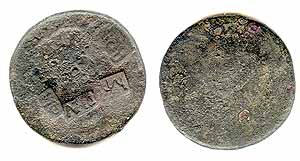
PRO,
TIAV, IMP, BON
Sestertius of
Claudius: 4
ctmks: PRO, TIAV, IMP, BON (35mm 21.5g)
Denominational
countermarks
from Germania Inferior
1. PRO -
Probatum meaning
'approved', countermark MPC 48
2. TIAV
-Tiberius Augustus
i.e. the emperor Claudius, countermark MPC 54
3. IMP -
Imperator, countermark
MPC 47
4. BON - Bonum -
for 'good',
countermark MPC 42
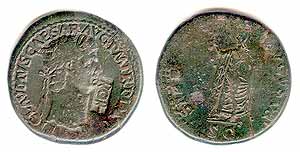
ROB
Another
imitative Sestertius
of Claudius: ROB ctmk. A rare variant of PROB 36.5mm 26.8g, subtype
countermark
to Martini Pangerl Collection 2, or 23
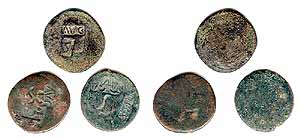
S
AVG TICAE
3 early Augustan
As with
multiple ctmk's: 2 coins have an incuse S. One has an raised S.
Possibly
revaluated to a semis? Also present are AVG and TI.CAE
(24mm 6.3g; 25mm
4.7g; 24.5mm
8.5g - this one is heavy. Maybe another reason for the ctmk),
Countermarks
Martini Pangerl Collection 83, equivalent to 4, 90.
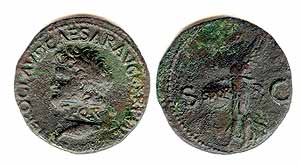
SPQR
As of Nero: SPQR
Mark of
Vindex (27.5mm 10.2g), Countermark Martini Pangerl Collection 26, 27
SPQR - Senatus
Populusque
Romanus - 'the senate and people of Rome'
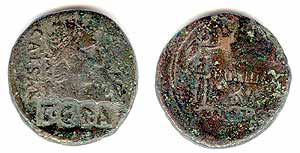
T•C•P•A
As of
Augustus: = Tiberius
Caesar Permissu Augusti ("Tiberius Caesar", with the permission of
Augustus)
(25mm 11.0g), Countermark Martini Pangerl Collection 28.
T•C•P•A
used near the end
of Augustus' reign, but possibly before he designated Tiberius as his
heir.
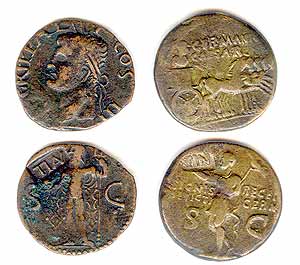
TIAV
Barbaric As of
Agrippa: TIAV
26mm 5.7g
Dupondius of
Germanicus:
TIN (TIAV) 27mm 12.4g, Countermark Martini Pangerl Collection54
TIAV: The
abbreviation of
Tiberius Augustus. In this instance not the emperor Tiberius, but
rather
Claudius whose first name was Tiberius. The name Claudius, though not
present
is meant to be implied by the usage of this countermark.
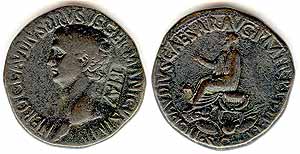
TIAV
Sestertius Nero
Claudius
Drusus: TIAV (35mm 29.4g), Countermark Martini Pangerl Collection 54
TIAV - Tiberius
Augustus
i.e the emperor Claudius
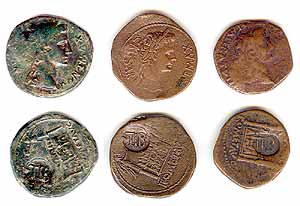
TIB
2 As of
Augustus; 1 As of
Tiberius: TIB (27mm 11.3g; 27mm 9.6g; 24mm 10.6g), Countermark Martini
Pangerl Collection 29
TIB abbreviation
for Tiberius.
Almost always found on the As' with the altar of Lugdunum reverse.
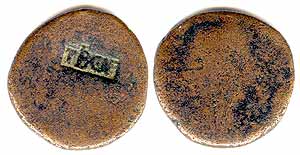
TIB•C•AVF
Very worn coin
with
monogram ctmk. for Tiberii Caesarii Augusti Filii = Tiberius "the
Caesar,
son of Augustus", Countermark Martini Pangerl Collection 32.
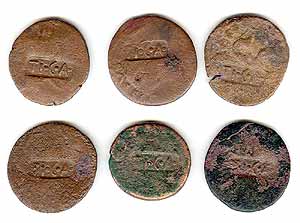
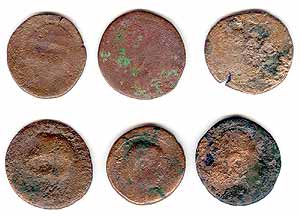
TI•C•A•
6 worn DIVVS As
of Augustus:
TI•C•A•
All 6 ctmk's
appear to be
from the same die and are possibly modern fakes on genuine worn coins.
At least 4 more
coins have
been seen on ebay that appear to be from the same ctmk die.
2 appear to be
countermarked
on the obverse and 4 to be countermarked on the reverse. Weights vary
from
7.7g to 10.4g and diameters from 25 to 28mm. Countermark Martini
Pangerl
Collection 89.
TI•C•A•
is thought to refer
to Tiberius Claudius Augustus (or by some as Tiberius Caesar Augustus
->
still referring to Claudius).
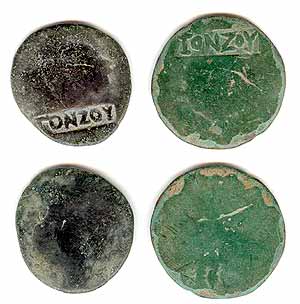
TONZOY
2 AE possibly
Flavian: TONZOY
The Tonzos was a river in Thrace. (21mm 4.3g; 22mm 3.6g)
There is an
example of a
35mm coin of Domitian from Nicea in Bythinia with the same countermark.
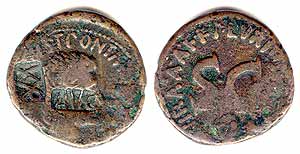
VAR
Early As of
Augustus (moneyer
P. Lurius Agrippa): AVG, VAR (not a Varus monogram as suggested by some, see the 'Varus debate page') 26mm 10.1g.
Countermark Martini Pangerl Collection 52.
VAR is usually
on Lugdunum
As, only few examples are known on moneyer AEs.
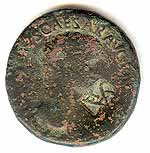
VESPA
Sestertius
Claudius: VESPA
monogram ctmk; Extremely rare on this host coin (34mm 27.0g),
Countermark
Martini Pangerl Collection 35.
VESPA monogram
for Vespasian.
Two similiar examples known, published by Garcia-Bellido in a paper
devoted
to some Hispanic provincial cmks.
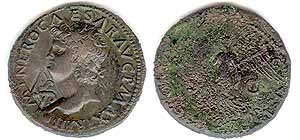
VESPA
As of Nero:
VESPA monogram
29mm 10.9g, Countermark Martini Pangerl Collection 35.
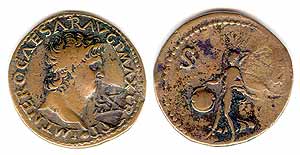
VESPA
As of Nero:
VESPA monogram
30mm 10.6g, Countermark Martini Pangerl Collection 35
The VESPA
monogram ctmk.
was struck in such a way as to not deface the image of Nero.
Vespasianus
was never in revolt against Nero, only the hated usurpers after him
(this
refers to Otho and Vitellius but not Galba, whom Vespasianus honored
with
a postumous coinage). By pairing his monogram next to the image and
legends
of Nero, he was trying to create a visual link to the now extinct
Julio-Claudian
dynasty.
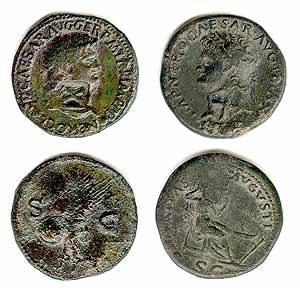
X
2 As of Nero: X
for Legion
10 Gemina (29mm 10.7g; 29mm 14.2g), Countermark Martini Pangerl
Collection
82.
The legion X
Gemina was stationed
in Pannonia in 68AD and took no active role in the revolt against Nero.
However, they did not back Galba as emperor and therefore decided to
strike
their own emblem on the coins of Nero, in such a way as not to deface
the
portrait.
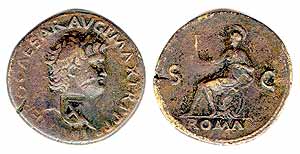
X
Sestertius Nero:
X countermark
for Legion X. Gemina (my opinion) 34mm 23.1g, Countermark Martini
Pangerl
Collection 82
Note the "cut"
on the cheek
Richard Baker
has several
examples of this Sestertii, two of them also have the cut across the
cheek.
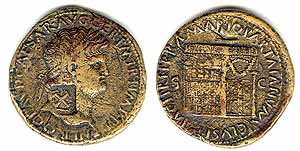
X
Sestertius Nero:
X countermark
for Legion X. Gemina (36mm 22.6g), Countermark Martini Pangerl
Collection
82.
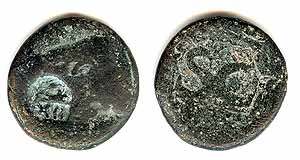
XII
AE of Antioch
(possibly Claudius):
XII - Legion 12 struck over Cornucopiae; (26mm 12.9g Howgego 737)
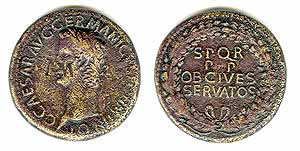
Unknown
CMK
Sestertius of
Caligula with
unknown incuse ctmk (35mm 28.9g) (resembles overlapping 'M's)
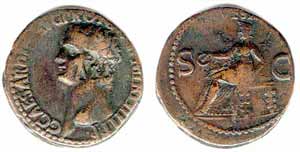
Unknown
CMK
As of Caligula:
unknown ctmk
28mm 11.0g
Scarcer host
coin struck
in the last few months of his reign.
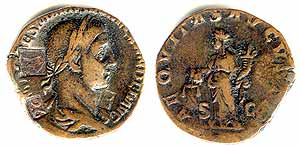
25, 26,
27,
Sestertius of
Severus Alexander:
3 numerals resembling '25', '26' and '27'
similar in style
to that
found on 16th century 'spanish' Flanders&Brabant coins (28mm
18.9g)
Possibly used as
a weight
of some kind in one of the various 'Guild Halls' - traces of lead along
one section of the rim has been removed